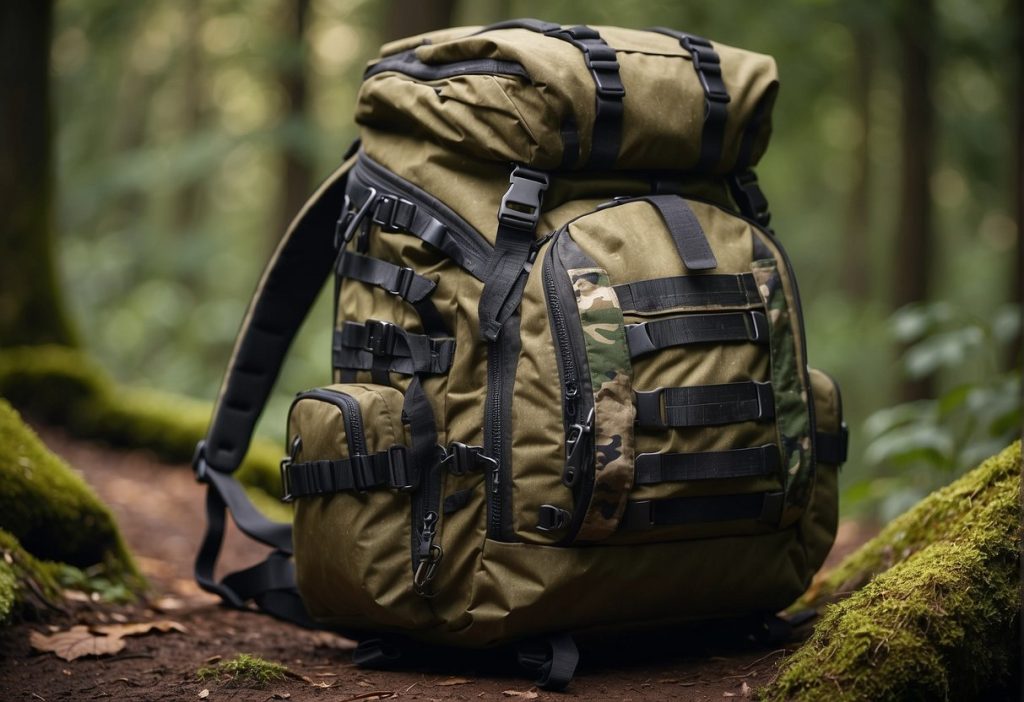
Bow hunting requires specialized gear and equipment, and one of the essential items for any bowhunter is a backpack specifically designed to accommodate the unique needs of this sport. The best bowhunting backpacks for bow hunting not only offer ample storage space for your gear but also provide innovative solutions for carrying your bow safely and efficiently. When looking for the best hunting backpacks, factors such as capacity, weight distribution, and attachment features for your bow are crucial in making the right choice.
Understanding the different types of backpacks available for bow hunters and their key features will help you make an informed decision. A high-quality backpack should be durable, comfortable, and adjustable to ensure a perfect fit during long treks through the wilderness. Additionally, factors such as budget, safety, and visibility concerns, as well as optional backpacking accessories and enhancements, will play a role in selecting the backpack that best suits your needs.
Key Takeaways
- Choose a backpack designed specifically for bow hunting with essential features like innovative storage solutions and attachment options for your bow.
- Ensure your backpack offers proper fit, adjustability, and weight distribution for maximum comfort during long hunting expeditions.
- Consider additional factors such as budget, quality, safety, and visibility when selecting the best bow hunting backpack for your needs.
Understanding Backpack Types
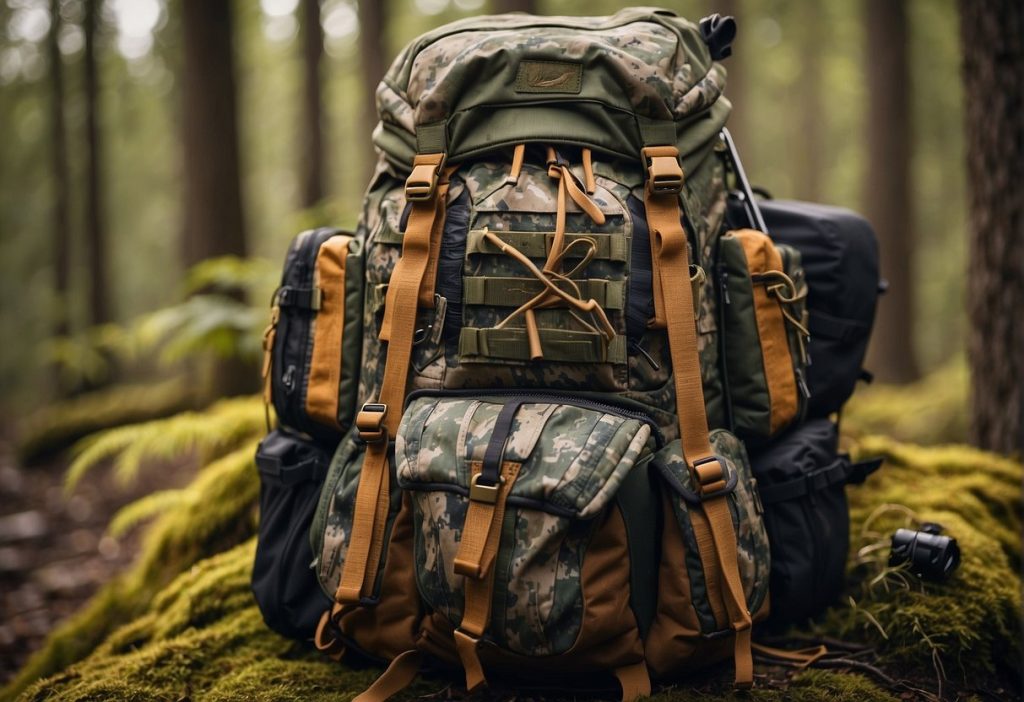
When it comes to bow hunting, choosing the right backpack is essential for a successful and comfortable hunt. In this section, we’ll explore the different types of hunting backpacks available, so you can find the perfect fit for your needs.
Best Day Pack
Hunting day packs are designed for a shorter hunting trip, usually lasting one day or less. These packs are lightweight, streamlined, and focus on providing just enough space for your essential gear. They typically come with lower weight capacities, making them perfect for quick hunts, scouting missions, or when you’re not going far from your base camp. When selecting a day pack, consider its comfort, size, and organization features. Some popular day packs mentioned in the search results include the Tenzing Hangtime Lumbar Pack and the Allen Terrain Cape Daypack 1350.
Multi-Day Pack
Multi-day packs, also known as backcountry packs, are designed for extended hunting trips that require you to carry more gear, clothing, and food. These larger packs have greater capacities, more compartments, and additional suspension systems to help distribute the weight and make longer hikes more comfortable. When choosing a multi-day pack, think about the duration of your trip, weight distribution, and additional features such as hydration compatibility. Some well-regarded multi-day packs include the Exo Mtn Gear K3 4800 and the Stone Glacier Sky Archer 6400.
Specialized Packs
Specialized packs are designed for specific hunting scenarios or with unique features tailored to a particular hunter’s needs. For bow hunting, this may include packs with dedicated bow carrying systems, built-in bino harnesses, or specific camouflaging patterns.
These packs prioritize versatility and can help you stay organized and efficient in the field. While they may not be as universally suitable as day or multi-day packs, specialized packs can make a big difference for particular hunting situations. A few examples of specialized packs are the INSIGHTS The Vision Bow Pack and the Badlands Bino XR which focuses on carrying binoculars.
Knowing the differences between day packs, multi-day packs, and specialized packs will help you make an informed decision when selecting a hunting backpack. Consider your hunting style, preferences, and the type of trips you typically embark on to determine the most suitable type for your needs.
Key Features of Bow Hunting Backpacks

Material and Durability
When choosing a bow hunting backpack, it is important to pay attention to the materials used in its construction. High-quality materials such as Nylon and Cordura fabric ensure durability and resistance to outdoor elements. Additionally, look for reinforced stitching in high-stress areas and water-resistant or waterproof coatings for added protection.
Design and Organization
A well-designed backpack for bow hunting will have specific compartments and features made to accommodate your equipment. Many backpacks include built-in bow carriers or holders to secure your bow during transport. Pockets and a main compartment should be easily accessible and quiet to open.
Opt for backpacks that offer the following:
- Silent zippers or fasteners
- External and internal pockets
- MOLLE attachment points for additional gear
Weight and Capacity
Bow hunting backpacks should strike a balance between weight and capacity. While you want a lightweight and streamlined good pack, it should also be able to carry all your hunting gear and essentials comfortably.
Consider the following:
- Heavier packs often have more padding and features, while lightweight packs may compromise on comfort.
- Assess the amount of gear you usually carry on a hunt to determine the required carrying capacity.
- Opt for backpacks with adjustable straps and load-lifter systems to distribute weight evenly across your body.
Comfort and Fit
Your comfort during long treks is crucial for a successful hunt. Prioritize backpacks that have padded shoulder straps, adjustable sternum straps, and a padded waist belt. A well-fitting bag reduces fatigue during long treks, keeping you focused on the hunt.
Additional features to look for include:
- Breathable back panels
- Adjustable torso length
- Load balancing systems for even weight distribution
Innovative Storage Solutions
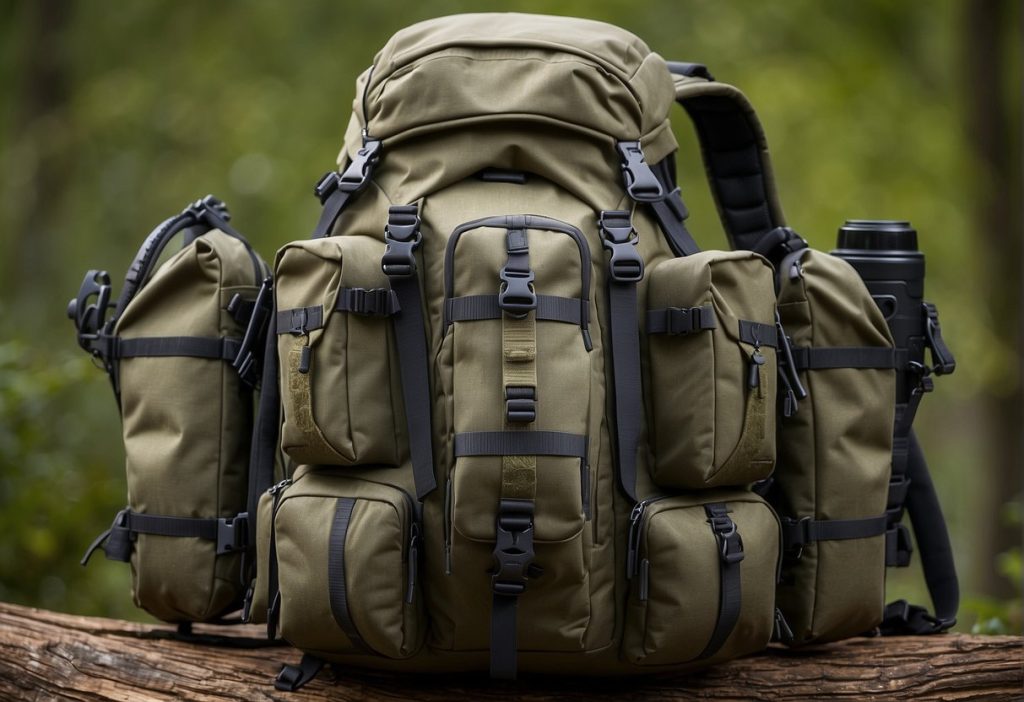
Meat Shelf
The meat shelf is a critical component of a bow-hunting backpack. It provides a separate compartment for storing game meat, keeping it away from other gear while allowing air circulation to preserve it. Some meat shelves can hold up to 100 pounds of meat, ensuring that you can carry your harvest efficiently. Meat shelves often utilize durable materials and reinforced stitching to handle the load and prevent wear and tear.
Hydration Bladder
A well-designed backpack for bow hunting includes a hydration bladder compartment. This feature allows for easy access to water without interrupting your hunt. Hydration bladders typically range in capacity from 2 to 3 liters, offering sufficient water supply for extended hunting sessions. They are securely stored in the backpack to prevent leaks and spills while remaining easily accessible in case you need to refill.
Weapon Enclosure
When it comes to protecting and securing your bow, a weapon enclosure is essential. This dedicated space ensures that your bow remains safe, secure, and ready to use when needed. Bowhunting backpacks often include specialized compartments for the bow and arrows, as well as additional storage capacity for other gear like rangefinders, GPS devices, and binoculars. By having a designated place for all your tools, you can effortlessly find and retrieve the necessary equipment without disturbing your hunting environment.
Overall, innovative storage solutions in bow hunting backpacks focus on optimizing space and convenience. From the meat shelf and hydration bladder to the weapon enclosure and organizing gear, these features ensure a seamless hunting experience while providing peace of mind that your equipment is protected and accessible.
Fit and Adjustability
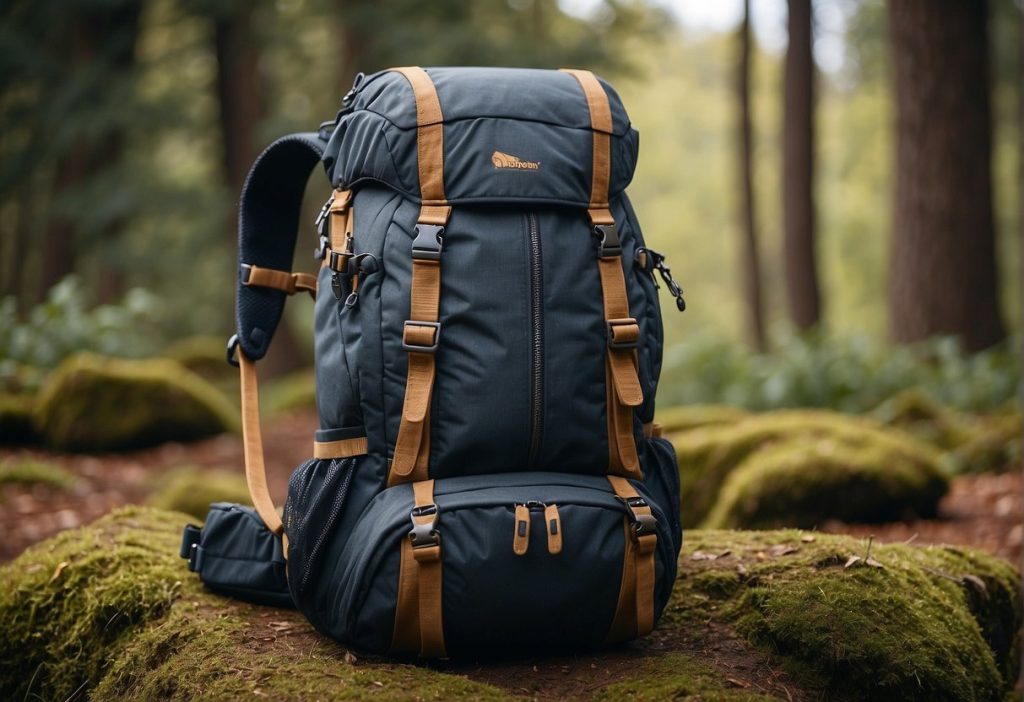
Shoulder Straps
When choosing the perfect bow hunting backpack, it’s crucial to find one with adjustable and comfortable shoulder straps. This feature ensures that the weight of your gear is evenly distributed across your shoulders, reducing the strain and discomfort during long hunting trips. Look for backpacks with padded straps or straps made from breathable material to avoid rubbing and sweat buildup. For example, the ALPS OutdoorZ Extreme Traverse X offers adjustable and comfortable shoulder straps, making it an excellent option for a day hunter.
Waist Belt
A well-fitted waist belt is another essential component to consider when selecting the best backpack for bow hunting. The waist belt helps to transfer the weight of your gear to your hips, taking the load off your shoulders and allowing for better balance and comfort. Opt for a backpack that features an adjustable waist belt to ensure a customized and secure fit, such as the Exo Mtn Gear K3 4800 Pack System.
Torso Lengths
Finally, finding a backpack that fits your unique torso length is crucial for both comfort and support. Pay attention to backpacks that offer adjustable torso lengths, allowing you to customize their fit based on your individual needs. Packs with customizable adjustments, such as the ones mentioned in NeoBackpacker’s guide ensure a perfect fit, regardless of your body size or shape.
In summary, prioritize fit and adjustability while searching for the ideal bow hunting backpack to guarantee a comfortable and supportive experience during your hunting trips. Pay attention to the shoulder straps, waist belt, and torso lengths to find a backpack that caters to your specific needs and body type.
Selecting the Right Capacity
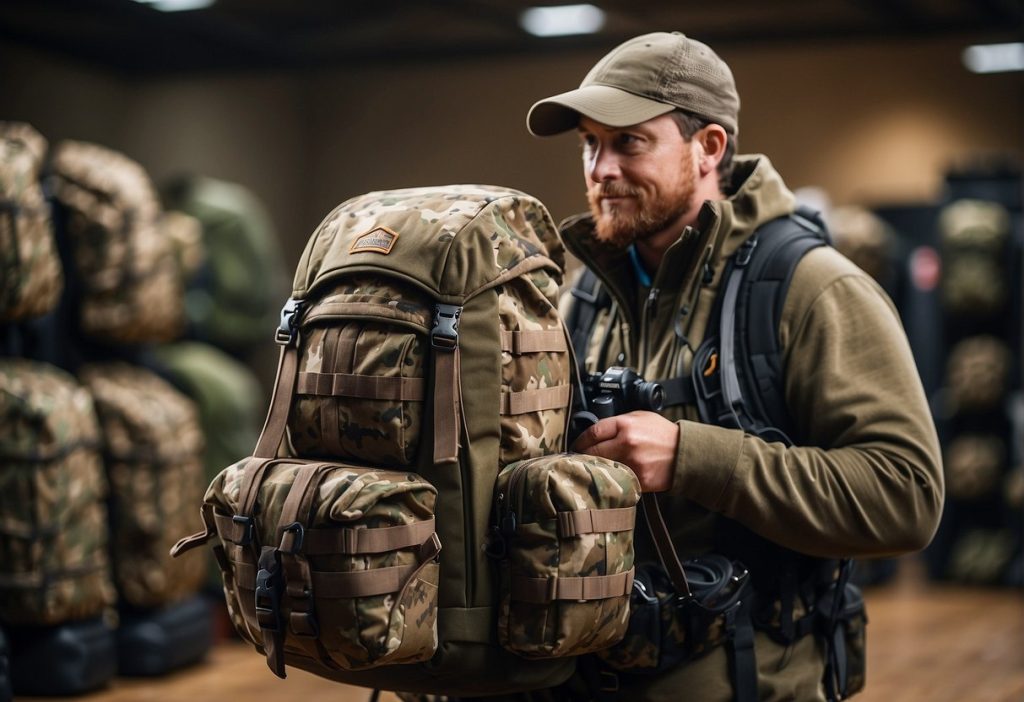
When looking for the perfect bow hunting backpack, it is crucial to consider its carrying capacity. In this section, we will discuss how to properly evaluate the storage compartments of a backpack by understanding cubic inches vs. liters and the importance of load rating and distribution.
Cubic Inches vs. Liters
When comparing backpack capacities, you may come across measurements in either cubic inches or liters. To make an informed decision, it is essential to understand the difference between these two units. One liter is equivalent to approximately 61 cubic inches. To convert a capacity from liters to cubic inches, simply multiply the number of liters by 61. Conversely, to convert from cubic inches to liters, divide the number of cubic inches by 61.
Here’s a quick reference table to help you visualize the conversion:
| Liters | Cubic Inches |
|---|---|
| 10 | 610 |
| 20 | 1,220 |
| 30 | 1,830 |
| 40 | 2,440 |
| 50 | 3,050 |
When selecting a backpack, consider the amount of gear you need to carry and choose a capacity that will accommodate all of your essentials without being unnecessarily large or heavy weight.
Load Rating and Distribution
Another crucial factor to consider when selecting a bow hunting backpack is its load rating. The load rating represents the maximum weight that the backpack is designed to comfortably and safely carry. Exceeding this limit can lead to decreased comfort and potentially damage the backpack. It is important to understand your gear’s weight as well as the backpack’s load rating to ensure a proper fit.
In addition to the load rating, pay attention to the backpack’s weight distribution. The design of the backpack should effectively distribute the load evenly across your body, which prevents discomfort, pain, or even injury during long hunting trips. Look for features such as adjustable straps, padded hip belts, and an internal frame to help distribute the weight.
By understanding the capacity of backpacks in cubic inches and liters, and considering the load rating and weight distribution, you can make an informed decision when selecting the best bow hunting backpack for your needs. Remember to take into account your specific gear requirements and personal comfort preferences in order to have a successful and enjoyable bow hunting experience.
Structural Support and Weight Distribution
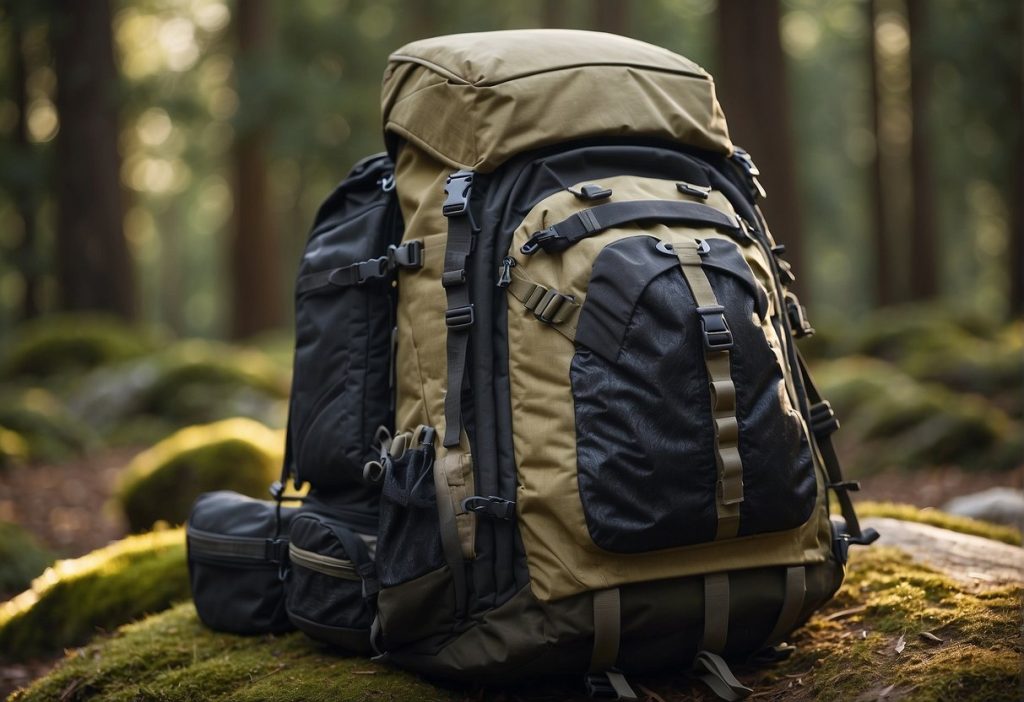
When choosing the best backpack for bow hunting, it is crucial to consider the structural support and weight distribution. These factors play a significant role in determining the overall performance and comfort of your backpack.
Internal Frame
An internal frame backpack is designed with its support structure hidden inside the pack, providing a sleek and streamlined appearance. This makes it an ideal choice for navigating through dense vegetation or rugged terrain. The internal frame is typically made from lightweight materials such as titanium, composite, and magnesium alloy. These materials offer excellent strength-to-weight ratios, ensuring that your pack remains light while providing the necessary support for carrying your hunting gear.
In general, an internal frame backpack offers better weight distribution and a closer fit to your body, enabling you to carry heavier loads more comfortably.
External Frame
An external frame backpack features a visible support structure, usually made from materials like aluminum or steel. While external frames tend to be heavier, they excel in load-bearing capabilities and provide more significant support for your hunting gear. External frame packs are known for their excellent weight distribution, allowing air circulation between the pack and your back.
This can help you stay cool during long treks and minimize the risk of back pain resulting from uneven weight distribution. However, due to their bulky framework, external frame packs may not be the best choice for navigating tight spaces or dense vegetation.
Suspension System
The suspension system plays a crucial role in the overall comfort and support of your backpack. A well-designed suspension system consists of adjustable shoulder straps, a padded hip belt, and load lifter straps. These components work together to transfer the weight of your gear from your shoulders to your hips, which is essential for maintaining balance and reducing fatigue during long hunts.
Here’s a summary of the key features of internal and external frame pack:
| Feature | Internal Frame | External Frame |
|---|---|---|
| Visibility | Hidden support structure inside the pack | Visible support structure outside the pack |
| Weight | Lightweight materials (titanium, composite) | Heavier materials (aluminum, steel) |
| Fit & Comfort | Better fit, closer to the body | Bulky structure, offer more air circulation |
| Terrain | Ideal for dense vegetation or rough terrain | May face difficulty in navigating tight spaces |
In conclusion, paying attention to features like the internal frame, external frame, and suspension system is essential to ensure your hunting backpack meets your specific needs. By evaluating these factors, you’ll be able to choose a backpack that provides the right balance of support, comfort, and weight distribution for your hunting adventures.
Attachment Features for Bow Hunters
Bow Attachment System
When looking for the perfect backpack, it is essential to consider the type of bow attachment system it offers. A well-designed bow attachment system allows you to securely fasten your bow to the backpack, providing stability and protection. Look for a backpack with adjustable and sturdy straps that can accommodate various bow sizes and shapes. The material of these straps should be strong and durable, such as aluminum, to endure rough conditions during hunting trips.
MOLLE Webbing
Another important feature to consider is the presence of MOLLE webbing, which provides additional attachment points for your gear. MOLLE (Modular Lightweight Load-carrying Equipment) is a versatile system that enables you to attach various pouches, gear, and accessories to your backpack. This customizable feature will allow you to organize and access your equipment easily. Remember, having a well-organized backpack ensures that you can quickly access your essentials without rummaging through your pack.
Compression Straps
Lastly, don’t forget to check for compression straps in your bow hunting backpack. These straps allow you to tighten and secure your gear, preventing it from shifting or moving around while you’re on the move. By providing proper weight distribution, compression straps help you maintain your balance in the field. Look for a backpack that offers adjustable straps, enabling you to adapt the pack’s fit according to your gear’s size and weight.
In summary, pay close attention to the bow attachment system, MOLLE webbing, and compression straps when searching for the best backpack for your bow hunting needs. These attachment features not only improve the functionality and organization of your pack but also contribute significantly to your comfort and mobility in the field.
Assessing the Backpack’s Quality
Fabric and Materials
When looking for the best backpack for bow hunting, it’s essential to consider the quality of the fabric and materials used. A durable and robust backpack is vital for withstanding harsh outdoor conditions. The 1680D nylon ballistic fabric is an excellent material commonly used in quality backpacks, offering good resistance to wear and tear.
Another high quality fabric option is the KXO-50 fabric, known for its light weight and waterproof features.
- 1680D nylon ballistic fabric: Provides outstanding durability and resistance to wear.
- KXO-50 fabric: Lightweight, waterproof, and remarkably tear-resistant fabric.
Zippers and Hardware
Apart from the fabric, the zippers and hardware are essential aspects to consider when assessing a backpack’s quality. These components contribute to the overall functionality and durability of the bag. Look for reliable zippers with sturdy construction and smooth operation. High-quality hardware, such as buckles and strap adjusters, should be made from durable materials like metal or heavy-duty plastic.
Here’s a quick comparison of the primary materials used in zippers and hardware:
| Material | Advantages | Disadvantages |
|---|---|---|
| Metal | Durable, strong, reliable | Heavier, may corrode over time |
| Plastic | Lightweight, water-resistant | May be less durable than metal |
By considering the quality of the fabric, zippers, and hardware in your backpack, you can ensure that it will serve you well during your bow hunting adventures. Remember that investing in a quality backpack made from durable materials will ensure its longevity and provide you with better long-term performance.
Backpacking Accessories and Enhancements
Hip Belts
When choosing a bow hunting backpack, you should consider how it distributes the weight across your body. A well-padded and adjustable hip belt is essential for balancing the load and reducing strain on your shoulders. It ensures that your hunting gear stays secure, while also allowing for easy accessibility. Some backpacks even feature pockets on the hip belt for quick access to essential small items like rangefinders or ammunition.
Rain Cover
It’s also crucial to look for a backpack that can withstand various weather conditions. A blaze orange rain cover is an excellent addition to your bow hunting gear. It not only keeps your backpack and its contents dry in wet conditions, but it also serves as a safety measure, making you visible to other hunters. Some backpacks come with an integrated rain cover, while others may have a separate cover you can purchase to match your needs.
Ventilation System
When hunting during warmer months or in areas with higher humidity, the importance of a ventilation system in your backpack cannot be underestimated. Look for backpacks with breathable mesh fabrics and padding or suspended ventilation systems that create an air gap between your back and the pack. Proper ventilation ensures better airflow, minimizing sweat buildup and keeping you comfortable during those long, demanding treks.
As you search for the best backpack for bow hunting, prioritize features like hip belts, rain covers, and a suitable ventilation system. These enhancements will ensure you are comfortable, protected, and prepared for any hunting conditions. Remember, a comfortable hunter is a successful hunter, so invest time in finding the perfect backpack that meets your bow hunting needs.
Safety and Visibility Concerns
Bright Colors and Reflective Materials
When bow hunting, safety and visibility are essential aspects to consider, especially during hunting late season with higher hunter presence. Choosing a bow hunting backpack with bright colors and reflective materials can significantly improve your visibility in the field, reducing the risk of accidents. Blaze orange is a personal choice and is often a mandatory requirement in many hunting areas.
A key component to safety is ensuring your backpack includes a blaze orange rain cover. This cover provides additional visibility during inclement weather, especially in low light conditions, while also keeping your gear protected and dry. To enhance visibility further, you can opt for backpacks with reflective details like straps or trims.
Reflective materials increase your safety by reflecting light from headlamps, flashlights, or even the sun, making you more visible to other hunters and avoiding potentially dangerous situations.
- Safety: A backpack with bright colors and reflective materials enhances your visibility in the field, promoting safer hunting practices.
- Visibility: Bright colors, especially blaze orange, allow other hunters to easily spot you from a distance, making the hunting experience safer for all participants.
- Blaze Orange Rain Cover: This accessory is essential for added visibility during harsh weather conditions and complying with hunting regulations in many areas.
By investing in a bow hunting backpack with safety and visibility features such as bright colors and reflective materials, you are not only complying with hunting regulations, but also prioritizing your own safety and that of other hunters in the field. Keep these elements in mind while making your choice to ensure a safer, more responsible bow hunting experience.
Budget and Price Considerations
When searching for the best backpack for bow hunting, it’s essential to consider your budget and the value you’re getting out of your purchase. The price of a backpack can vary greatly, which is why it’s important to find the perfect balance between affordability and quality.
Finding the Best Value
To find the best value, you need to consider multiple factors, such as price, durability, and functionality.
Here are some tips to help you find the best bow hunting backpack that meets your budget and needs:
- Research: Look up reviews and ratings from fellow bowhunters who have already tried the backpacks you’re considering. They can provide valuable insights into the backpack’s performance and durability.
- Price range: Determine your price range based on your budget. Remember that the costliest backpack might not always be the best option. Look for a backpack that offers the essential features you need (like a bow carrier option) at a price that suits your budget.
- Material and construction: A high-quality backpack should be made of durable materials that can withstand the rigors of hunting. Nylon and polyester are two popular options for their toughness and water-resistant properties.
- Comfort and utility: Prioritize backpacks that offer comfort, such as padded shoulder straps and adjustable waist belts. It’s also essential for the backpack to have accessible compartments and pockets for your hunting gear.
- Warranty: A good warranty can serve as an indicator of the manufacturer’s confidence in their product. Consider different packs that come with a comprehensive warranty, which may cover damage or defects. Some brands, like Badlands, are known for their excellent warranty coverage.
By thoroughly assessing your needs and following these tips, you can confidently find the best value backpack for bow hunting within your budget and enjoy a successful hunting experience.
Frequently Asked Questions
What features should I look for in a high-quality bow hunting backpack?
When looking for a high-quality bow hunting backpack, focus on features like durability, functionality, and comfort. A good backpack should be made of strong materials such as ripstop fabric that can withstand the test of time. It should have adequate storage and compartments to organize your gear, including a bow or rifle holder. Comfort is essential, so look for padded shoulder straps, a good suspension system, and a ventilated back panel. Additionally, consider water resistance and camouflage patterns if you hunt in wet conditions or need to remain hidden.
How do I choose a backpack that can securely hold my compound bow?
To securely hold your compound bow, choose a backpack that includes a dedicated bow attachment system or a pocket with straps that can easily accommodate your bow. You may also need to consider carrying your bow disassembled if the backpack has smaller compartments. Read product descriptions and user reviews to get a good idea of how well the backpack you’re considering can hold a bow.
Can you recommend a hunting backpack that’s suitable for day trips and is lightweight?
For day trips and lightweight hunting needs, consider the ALPS OutdoorZ Pursuit Pack. This backpack is designed for all-day comfort and offers enough storage for your essential gear. The bow holder and vented back panel enhance its usability and convenience during hunting trips.
What are the most durable brands for bow hunting backpacks?
Some of the most durable brands for bow hunting backpacks include ALPS OutdoorZ, Badlands, and Stone Glacier. These brands have a reputation for producing high-quality, long-lasting hunting backpacks that can withstand the demands of the outdoors.
How important is the fit and comfort of a backpack while bow hunting for extended periods?
The fit and comfort of a backpack are critical when bow hunting for extended periods. A well-fitting and comfortable backpack can prevent back pain and fatigue, allowing you to focus on your hunting experience. Look for adjustable, padded shoulder straps and hip belts, a suspension system that evenly distributes weight, and a ventilated back panel for increased breathability.
What’s the ideal backpack capacity to carry hunting gear and pack out game like deer?
The ideal backpack capacity depends on your hunting style and specific needs. A larger capacity, around 3,000 to 4,800 cubic inches, might be suitable for multi-day hunts, while a smaller capacity, about 1,500 to 2,500 cubic inches, would be more appropriate for day trips. To carry hunting gear and pack out game like deer, consider a hunting backpack with a built-in meat shelf or external attachment options that allow you to secure your game. Exo Mtn Gear K3 4800 Pack System could be an option to consider as it offers ample capacity and meat-hauling capabilities.
